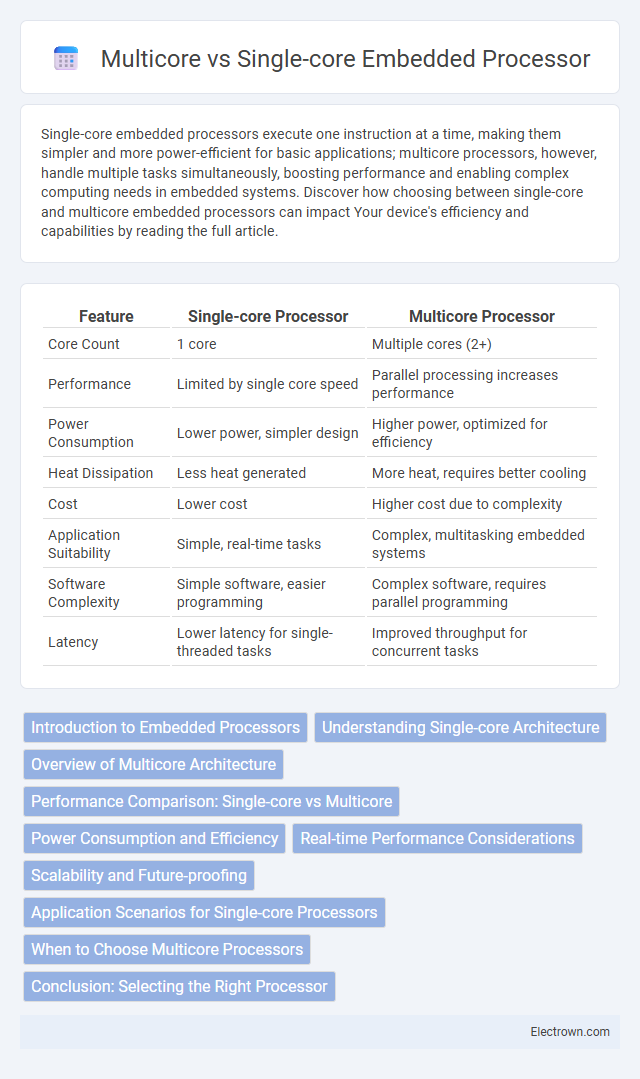Single-core embedded processors execute one instruction at a time, making them simpler and more power-efficient for basic applications; multicore processors, however, handle multiple tasks simultaneously, boosting performance and enabling complex computing needs in embedded systems. Discover how choosing between single-core and multicore embedded processors can impact Your device's efficiency and capabilities by reading the full article.
Table of Comparison
| Feature | Single-core Processor | Multicore Processor |
|---|---|---|
| Core Count | 1 core | Multiple cores (2+) |
| Performance | Limited by single core speed | Parallel processing increases performance |
| Power Consumption | Lower power, simpler design | Higher power, optimized for efficiency |
| Heat Dissipation | Less heat generated | More heat, requires better cooling |
| Cost | Lower cost | Higher cost due to complexity |
| Application Suitability | Simple, real-time tasks | Complex, multitasking embedded systems |
| Software Complexity | Simple software, easier programming | Complex software, requires parallel programming |
| Latency | Lower latency for single-threaded tasks | Improved throughput for concurrent tasks |
Introduction to Embedded Processors
Embedded processors are specialized microcontrollers designed to efficiently execute specific tasks within embedded systems, with single-core variants handling one instruction thread and multicore processors managing multiple threads concurrently to enhance performance. Single-core embedded processors provide simplicity and lower power consumption, making them ideal for cost-sensitive applications, while multicore designs offer increased processing power and responsiveness for complex, real-time tasks. Understanding the trade-offs between single-core and multicore embedded processors helps you select the optimal solution for your application's performance, power, and cost requirements.
Understanding Single-core Architecture
Single-core embedded processors consist of a single central processing unit (CPU) that executes one instruction thread at a time, making them simpler in design and easier to program for real-time applications. These processors typically consume less power and generate less heat, which is critical for battery-powered and resource-constrained embedded systems. Understanding single-core architecture involves recognizing its limitations in multitasking and parallel processing compared to multicore processors, but also its advantages in deterministic performance and reduced complexity.
Overview of Multicore Architecture
Multicore embedded processors feature multiple processing units, or cores, within a single chip, enabling parallel execution of tasks and improved performance compared to single-core processors. This architecture enhances power efficiency and responsiveness in real-time applications by distributing workloads across cores, reducing latency and increasing throughput. Your choice of multicore architecture depends on factors like application complexity, power constraints, and real-time processing requirements to optimize system performance.
Performance Comparison: Single-core vs Multicore
Multicore embedded processors deliver significantly higher performance than single-core processors by enabling parallel execution of tasks, which reduces processing time and increases efficiency in real-time applications. Single-core processors may struggle with multitasking and complex computations, leading to bottlenecks in performance for demanding embedded systems. Your system's performance requirements and workload characteristics determine whether the scalability and responsiveness of multicore architecture outweigh the simplicity and lower power consumption of single-core designs.
Power Consumption and Efficiency
Single-core embedded processors typically consume less power under low workloads due to their simpler architecture but may become inefficient when handling complex tasks, leading to higher energy use over time. Multicore embedded processors distribute workloads across multiple cores, improving efficiency by reducing processing time and allowing cores to operate at lower frequencies, optimizing power consumption during intensive applications. Your choice between single-core and multicore processors should consider the balance between power efficiency and the processing demands of your specific embedded system.
Real-time Performance Considerations
Single-core embedded processors often offer predictable real-time performance due to their simpler architecture and consistent execution timing, making them ideal for applications with strict timing constraints. Multicore embedded processors provide higher computational power and parallel processing capabilities but can introduce complexities in task scheduling and potential latency issues that affect real-time performance. Your choice should balance processing power needs against the determinism required for the real-time system, considering factors such as interrupt handling, synchronization overhead, and software support.
Scalability and Future-proofing
Multicore embedded processors offer superior scalability by allowing simultaneous processing of multiple tasks, enhancing performance as application demands grow. Single-core processors lack this flexibility, potentially limiting your system's ability to handle future software or firmware updates efficiently. Investing in multicore technology ensures better future-proofing by accommodating increasing computational complexity and enabling more advanced embedded applications over time.
Application Scenarios for Single-core Processors
Single-core embedded processors are ideal for applications with predictable, low to moderate processing needs, such as simple sensor controls, home appliances, and automotive systems where real-time responsiveness is crucial. These processors offer cost-effective solutions with lower power consumption, making them suitable for battery-operated devices and basic control tasks. Your choice of a single-core processor benefits embedded designs requiring deterministic behavior without the complexity of parallel processing.
When to Choose Multicore Processors
Multicore embedded processors are ideal for applications requiring parallel processing, such as real-time data analytics, multimedia processing, and advanced signal processing in automotive or IoT devices. They offer enhanced performance, lower power consumption per task, and improved system reliability through task segregation during multitasking environments. Choosing a multicore processor becomes essential when scalability, energy efficiency, and handling complex workloads simultaneously outweigh the simplicity of single-core designs.
Conclusion: Selecting the Right Processor
Choosing between a single-core and multicore embedded processor depends on your application's performance needs and power constraints. Single-core processors offer simplicity and lower power consumption, ideal for basic tasks and cost-sensitive designs. Multicore processors provide enhanced parallelism and higher throughput, making them suitable for complex, multitasking, or real-time applications requiring greater computational power.
Single-core vs multicore embedded processor Infographic

 electrown.com
electrown.com